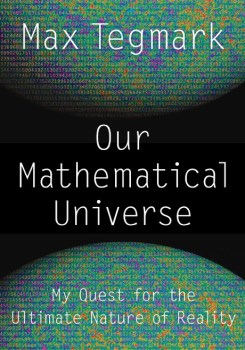Why We Should Think Big
An MIT physics professor discusses how mathematics is integrated into every part of our universe.
Let’s think big! We humans have repeatedly underestimated not only the size of our cosmos, but also our ability to understand and improve it. Over and over again, we’ve realized that everything we thought existed was merely a small part of a grander structure: our planet, solar system, galaxy, universe, and perhaps even one or more levels of multiverse.
How have we managed to understand so much about our cosmos even though it’s vastly larger than us? In part because it hides an elegant simplicity and beauty, revealed by mathematical shapes, patterns, and regularities that encode great predictive power. The Higgs Boson was predicted with the same tool as the planet Neptune and the radio wave were: with mathematics.
But why does our universe seem so mathematical, and what does it mean? In my new book, “Our Mathematical Universe,” I explore the possibility that our universe isn’t just described by math, but that it is math in the sense that we’re all parts of a giant mathematical object, which in turn is part of a multiverse so huge that it makes the other multiverses debated in recent years seem puny in comparison.
At first glance, our universe doesn’t seem very mathematical at all. The groundhog who trims our lawn has properties such as cuteness and fluffiness—not mathematical properties. Yet we know that this groundhog—and everything else in our universe—is ultimately made of elementary particles such as quarks and electrons—and what properties does an electron have? Properties like -1, ½ and 1! We physicists call these properties electric charge, spin, and lepton number, but those are just words that we’ve made up, and the fundamental properties that an electron has are just numbers, mathematical properties. All elementary particles, the building blocks of everything around, are purely mathematical objects in the sense that they don’t have any properties except for mathematical properties. The same goes for the space that these particles are in, which has only mathematical properties—for example, 3, the number of dimensions. If space is mathematical and everything in space is also mathematical, then the idea that everything is mathematical doesn’t sound as crazy anymore.

That our universe is approximately described by mathematics means that some but not all of its properties are mathematical, and it’s a venerable idea dating back to the ancient Greeks. That it is mathematical means that all of its properties are mathematical, i.e., that it has no properties at all except mathematical ones. If this is true, then it’s good news for physics, because all properties of our universe can in principle be understood if we’re intelligent and creative enough. For example, this challenges the common assumption that we can never understand consciousness. Instead, it optimistically suggests that consciousness can one day be understood as a state of matter, forming the most beautifully complex structure in space and time that our universe has ever known. Such understanding would enlighten our approaches to animals, unresponsive patients, and future ultra-intelligent machines, with wide-ranging ethical, legal, and technological implications.
In summary, our human quest for knowledge has revealed a grander-than-expected cosmos that we have greater-than-expected abilities to understand and improve through ingenuity and technology. I find this quest so inspiring that I decided to join it and become a physicist, and I’ve written this book because I want to share these empowering journeys of discovery, especially in this day and age when it’s so easy to feel powerless. If you decide to read it, then it will be not only the quest of me and my fellow physicists, but our quest.
Max Tegmark is a physics professor at the Massachusetts Institute of Technology in Cambridge, Massachusetts.